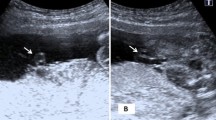Abstract
Purpose
To determine reference values for umbilical Doppler pulsatility index in fetuses with isolated two-vessel cord and to compare these values with standard umbilical Doppler pulsatility index curves from 23 to 40 gestational weeks.
Methods
A retrospective longitudinal cohort study was conducted between January 2014 and December 2017 in a tertiary referral hospital and included 62 pregnant women with isolated single umbilical artery (two-vessel cord) and 174 measurements. Only uncomplicated term pregnancies were included. A reference curve for umbilical Doppler pulsatility index was built up and compared with a standard curve commonly used for fetuses with three-vessel cord.
Results
Umbilical Doppler pulsatility index values were much lower than expected in cases with two-vessel cord compared to 3-vessel cord: mean of the regression equations was 1.02 ± 0.23 vs. 0.86 ± 0.19, respectively (p value < 0.001). This difference was quite constant across the gestational weeks considered, showing that the slopes of the two regressions were very similar.
Conclusion
Reference curves for umbilical Doppler pulsatility index in two-vessel cord pregnancies were determined. Pulsatility index values were significantly different compared with those commonly used for three-vessel cord. Using lower reference values for umbilical pulsatility index in cases with two-vessel cord may allow a better identification of fetuses affected with intrauterine growth restriction, thus improving fetal surveillance.

Similar content being viewed by others
References
Parilla BV, Tamura RK, MacGregor SN, Geibel LJ, Sabbagha RE (1995) The clinical significance of a single umbilical artery as an isolated finding on prenatal ultrasound. Obstet Gynecol. 85:570–572
Hua M, Odibo AO, Macones GA, Roehl KA, Crane JP, Cahill AG, et al (2010) Single umbilical artery and its associated findings. Obstet Gynecol 115:930–934.
Martínez-Payo C, Cabezas E, Nieto Y, Azúa MRd, García-Benasach F, Iglesias E (v) Detection of single umbilical artery in the first trimester ultrasound: its value as a marker of fetal malformation. Biomed Res Int
ISUOG Practice Guidelines: performance of first-trimester fetal ultrasound scan UOG, vol 41 n, pp 102–113, 2013.
Lamberty CO, de Carvalho MHB, Miguelez J, Liao AW, Zugaib M (2011) Ultrasound detection rate of single umbilical artery in the first trimester of pregnancy. Prenat Diagn 31(9):865–868.
Jacques SA, Steven LW, David MS, Levy DL, Woods JR (1991) Value of a random single Doppler study of the umbilical artery for predicting perinatal outcome. J Ultrasound Med 10(6):337-339.
Pierce BT, Dance V, Wagner RK, Apodaca CC, Nielsen PE, Calhoun BC (2001) Perinatal outcome following fetal single umbilical artery diagnosis. J Matern Fetal Med 10:59–63
Murphy-Kaulbeck L, Doods L, Joseph KS, van den Hof M (2010) Single umbilical artery risk factors and pregnancy outcomes.Obstetr Gynecol 116(4):843–850.
Catanzarite VA, Hendricks S, Maida C, Westbrook C, Cousins L, Schrimmer D (1995) Prenatal diagnosis of the two-vessel cord: implications for patient counselling and obstetric management. Ultrasound Obstet Gynecol 5:98–105
Voskamp BJ, Fleurke-Rozema H, Oude-Rengerink K et al (2013) Relationship of isolated single umbilical artery to fetal growth, aneuploidy and perinatal mortality: systematic review and meta-analysis. Ultrasound Obstet Gynecol. 42(6):622–628
Sterne GSL, Dubinsky TJ (2001) Abnormal fetal cerebral andumbilical Doppler measurements in fetuses with intrauterine growth restriction predicts the severity of perinatal morbidity.J Clin Ultrasound 29:146–151.
Chang CH, Chang F, Yu CH, Liang RI, Ko HC, Chen HY (2000) Systemic assessment of fetal hemodynamics by Doppler ultrasound. Ultrasound Med Biol 26:777–785
Gornall AS, Kurinczuk JJ, Konje JC (2003) Antenatal detection of a single umbilical artery: does it matter? Prenat Diagn 23:117–123.
Joel B, Adi YW, Yael S, Salvatore AM, Speigel E, Hershkovitz R (2015) Umbilical artery blood flows among pregnancies with single umbilical artery: a prospective casecontrol study. J Matern Fetal Neonatal Med 28(15):1803–1805.
Goldkrand JW, Pettigrew C, Lentz SU et al (2001) Volumetric umbilical artery blood flow: comparison of the normal versus the single umbilical artery cord. J Matern Fetal Med 10:116–121.
Hershkovitz R, Sheiner E, Mazor M (2006) Middle cerebral artery blood flow velocimetry among healthy fetuses with a single umbilical artery. J Ultrasound Med 25:1405–1408.
Sepulveda W, Peek MJ, Hassan J et al (1996) Umbilical vein to artery ratio in fetuses with single umbilical artery. Ultrasound Obstet Gynecol 8:23–26.
Acharya G, Wilsgaard T, Berntsen GK, Maltau JM, Kiserud T(2005) Reference ranges for serial measurements of blood velocity and pulsatility index at the intra-abdominal portion, and fetal and placental ends of the umbilical artery. Ultrasound Obstet Gynecol 26(2):162–169.
Glantz SA, Slinker BK (1990) Primer of applied regression and analysis of variance 1st edition
Funding
The authors received no specific funding for this work.
Author information
Authors and Affiliations
Contributions
EC: protocol/project development, data collection, and manuscript writing. IC: data collection. DM: protocol/project development, data collection, and manuscript writing. AF: protocol/project development, data collection, manuscript writing, and data analysis.
Corresponding author
Ethics declarations
Conflict of interest
We declare that we have no conflict of interest.
Ethical approval
All procedures performed in studies involving human participants were in accordance with the ethical standards of the Sant’Orsola Malpighi Hospital Bologna, Italy and with the 1964 Helsinki declaration and its later amendments or comparable ethical standards.
Informed consent
Informed consent was obtained from all individual participants included in the study.
Additional information
Publisher's Note
Springer Nature remains neutral with regard to jurisdictional claims in published maps and institutional affiliations.
Rights and permissions
About this article
Cite this article
Contro, E., Cataneo, I., Morano, D. et al. Reference charts for umbilical Doppler pulsatility index in fetuses with isolated two-vessel cord. Arch Gynecol Obstet 299, 947–951 (2019). https://doi.org/10.1007/s00404-019-05086-z
Received:
Accepted:
Published:
Issue Date:
DOI: https://doi.org/10.1007/s00404-019-05086-z




